A complete guide on making steamed dumplings from scratch. Two types of dough are introduced, as well as a collection of filling recipes, folding techniques, dipping sauce ideas and make-ahead suggestions. A tutorial video is also included.
A complete guide on steamed dumplings
In this complete guide on Chinese dim sum style steamed dumplings, I’m introducing two popular types:
- Regular dumplings (top ones in image above) which are made with flour-based wrappers.
- Crystal dumplings (bottom ones in image above) which are made with starch-based wrappers. After steaming, they look semi-transparent. The popular example is the classic dim sum dish Har Gow (crystal shrimp dumpling).
Here is a summary of what’s included in this guide:
- Why should you make dim sum style steamed dumplings
- How to make perfect dough for steamed dumplings
- How to roll the wrappers efficiently
- 10+ dumpling filling combinations
- How to fold dumplings into beautiful shapes
- Tips & tricks on how to steam dumplings
- Dipping sauce ideas for serving
- Advice on reheating leftovers and freezing uncooked dumplings
- A tutorial video showing the entire process
In each part, I also include a “Frequently Asked Questions” section based on the questions I’ve received on related dumpling recipes.
Why should you make steamed dumplings
Growing up with dumplings as part of my regular diet, I love all types! However, steamed dumplings do have some advantages over boiled or pan-fried ones.
- The cooking time is short and stress-free. You can just set a timer and relax. No need to stand beside the cooker.
- The shape of the dumplings is well maintained during cooking.
- A little leakage or imperfection won’t cause big problems so it’s novice-friendly.
- You can use starch to make semi-transparent crystal dumplings which are visually appealing and can be gluten-free (if you use gluten-free wheat starch).
How to make steamed dumpling dough
The flour-based dough
To make 24 regular dumplings (with non-transparent skin), you will need:
- 230g all-purpose flour/plain flour
- 100g boiling water
- 30g room temperature water
If you’ve read my post “Homemade Dumpling Wrappers”, you probably have noticed that this ingredient list is a little different. Instead of using just room temperature water, I made a “hot water dough” which produces a softer, less chewy texture after cooking. Also, it’s much easier to knead and roll (An ideal start for the dumpling novice).
- Firstly, pour boiling water over the flour while mixing with chopsticks.
- Then add the room temperature water. Stir until no more liquid can be seen.
- Combine and knead the dough with your hands until it becomes smooth.
- Cover the bowl then rest for 30 minutes.
The starch-based dough
To make 24 crystal dumplings (with semi-transparent skin), you will need:
- 100g wheat starch (澄粉)
- 70g tapioca starch/cornstarch
- 170g boiling water
- 2 teaspoon cooking oil
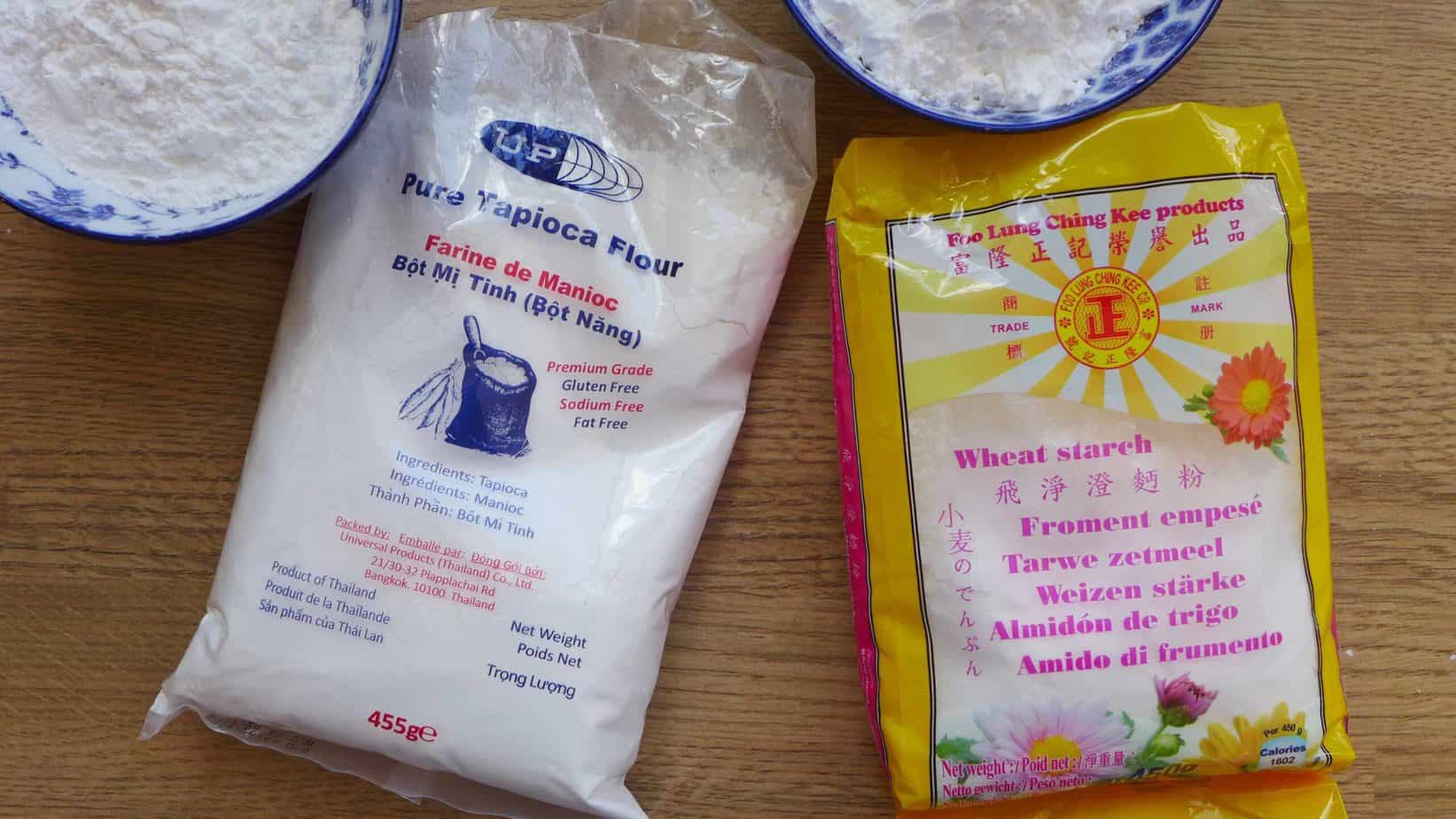
For the starch-based dough, there is one rule you must follow: the water has to be just boiled. Otherwise, your dough won’t be as elastic thus become difficult to shape. The worst case happens when the water temperature is too low: you’ll end up with a sloppy, sticky mass or just a bowl of starchy water (don’t ask me how I figured this out!).
Here is how I make the dough step by step:
- Mix wheat starch and tapioca starch (or cornstarch) in a bowl then place it on a kitchen scale.
- Boil water (more than the quantity suggested in the recipe as you need to consider evaporation) in a kettle or a pot. Once fully boiled, pour the suggested quantity over the starch straight away (without transferring it to a measuring cup as it will result in temperature drop).
- Stir with chopsticks immediately to distribute the water evenly. Then add the oil.
- Combine and knead with your hands until smooth and elastic.
No resting is required for this type of dough. You can start assembling right away. Cover the dough very well if you haven’t prepared the filling. Do not leave it too long though. Otherwise, its texture will change thus won’t be workable.
FAQ
A: Yes, you can, particularly when making a bigger batch. However, I don’t think it’s necessary for making crystal dumpling dough. It’s much easier to combine and knead this type of dough than flour-based dough.
A: Not really. Wheat starch is the key ingredient for this type of dumplings. You should be able to get it in Chinese/Asian stores, as well as online shopping platforms like Amazon.
A: Strictly speaking, it’s not 100 % gluten-free as the wheat starch contains a small amount of gluten (even after the process of removing gluten). I believe this is the case with Chinese branded ones. However, wheat starch specially labelled as “gluten-free/codex” is safe to use for coeliacs (Read this for more).
How to roll the wrappers
Is rolling the wrappers the most intimidating part for you? I can relate to that feeling. I thought I’d never master this skill when I was a child watching my dad’s hands “flying” with a rolling pin. But I did. Start at a slow pace and keep practising. It won’t take you very long to become very efficient at this. I promise!
The classic “roll & turn” method
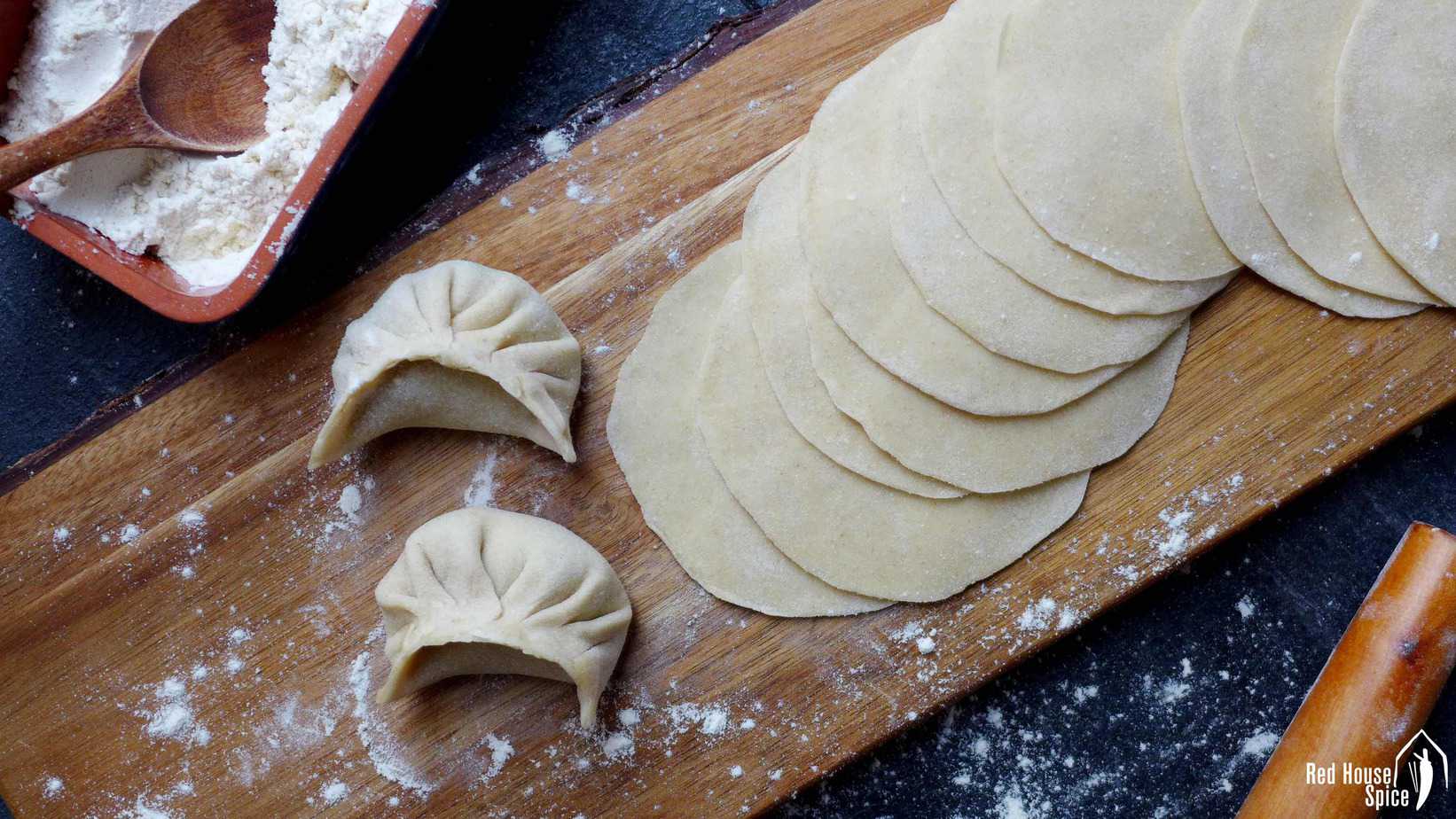
Although you’re free to use any way you like to roll the wrapper, I always encourage you to try the “roll & turn” method: One hand moves the rolling pin halfway over the dough and then rolls back. The other hand turns the wrapper a little each time in a circular motion (The video in the recipe card below clearly demonstrates the process). It’s the most efficient method and you’ll get perfect dumpling wrappers which are thick in the middle and thin on the edge.
Use a cleave to shape crystal wrappers

For shaping crystal wrappers, you can also use a traditional method with a cleaver instead of a rolling pin: Put a ball of dough underneath the side of a cleaver. Press while moving the cleaver side to side until the desired thickness is achieved. If the dough sticks a little, coat the cleaver (and the work surface) with a thin layer of oil.
FAQ
A: This can happen to crystal wrappers when the dough is too dry. You can fix it by wetting your hand with water then kneading the moisture into the dough. Also, remember to cover the unused dough at all times.
A: Yes, you can. Flour-based regular wrappers are easily accessible in Chinese shops. However, starch-based crystal wrappers aren’t commercially available.
How to make a delicious filling
Once you understand a few basic principles, it’s very easy to come up with a delicious dumpling filling by mixing and matching your favourite ingredients. In my post “How to Make Great Dumpling Fillings”, I’ve shared in-depth information on this subject.
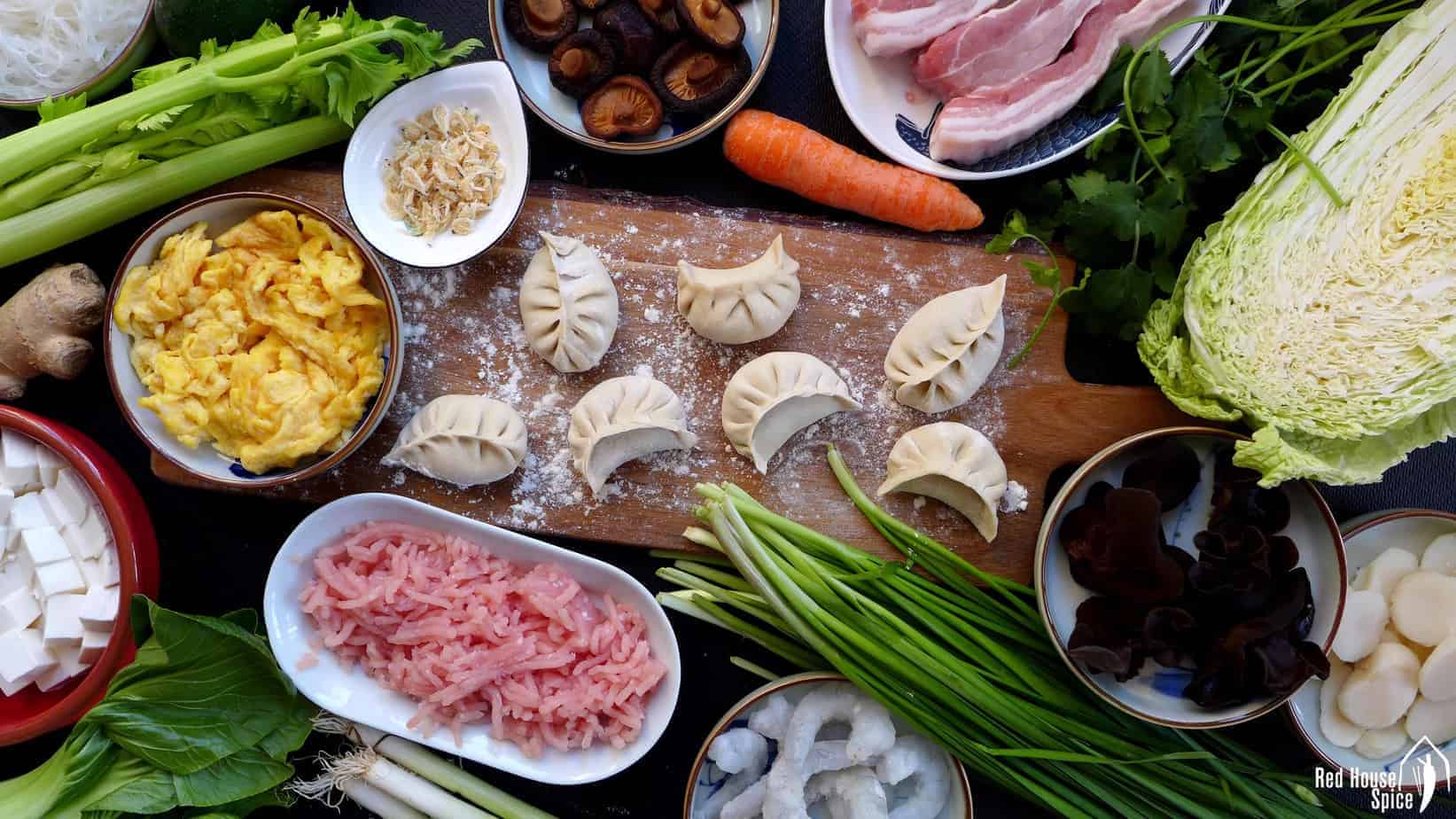
In today’s post, I’ve included a filling recipe as an example. You can also find quite a few other filling ideas in dumpling recipes I previously shared on the blog.
- Chinese chive & pork filling (Today’s recipe). You can find the full list of ingredients for this classic filling in the recipe card below. It’s my all time favourite (Chinese chives make everything extra tasty). Dried shrimp and water chestnuts are also added for an extra umami taste and crunchy texture.
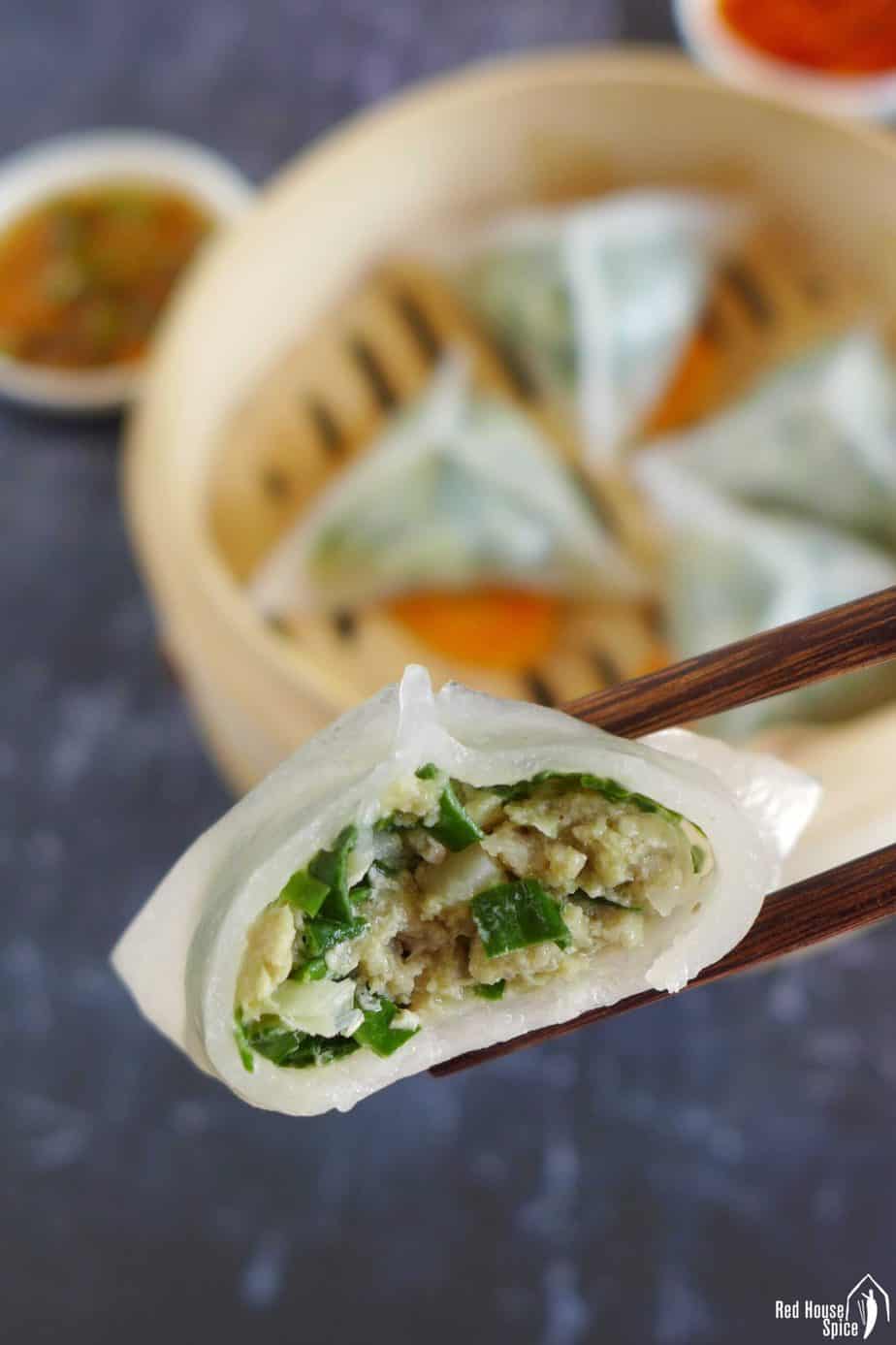
- Chicken & sweetcorn filling. This is the new regular in our Red House which is adored by my children. Great taste and texture!
- Beef & Chinese chive filling. The classic filling for the famous street food “Hot & Sour dumpling soup” from Xi’an, China.
- Dim sum style shrimp filling. This is from my recipe for steamed crystal shrimp dumpling (Har Gow) which is the most ordered item in Dim Sum restaurants.
- Pork & scallions filling. The classic taste of Shanghai street food Sheng Jian Bao (Pan-fried pork buns). It’s kind of addictive!
- Soup dumpling filling. My recipe for the legendary Xiao Long Bao shows you how to make aspic for the filling to maximise the “soupy” sensation.
- Shrimp, pork & mushroom filling. You can find this one in my recipe for “Easy Shumai”.
- Pork, carrot & onion filling. My popular post “Steamed Bao Bun” uses this combination. It’s great for steamed dumplings too!
- Chinese chive, egg & vermicelli filing (vegetarian). I use this filling for making Chive chive pockets, a popular speciality in Northern China.
- Bok Choy, mushroom & vermicelli filling (vegetarian). You can find this filling in my post on bi-colour pan-fried dumplings.
- Five-spice tofu & vegetable filling (vegan). A very tasty filling using flavoured tofu. You must try it if you’re looking for vegan options.
FAQ
A: You can achieve the goal by ①using meat with a higher content of fat, ②adding a little oil or ③ incorporating more water/stock into the meat.
How to assemble the dumplings
Once you’ve rolled out a few wrappers, it’s time to start assembling. If you are working on your own, roll maximum 5 wrappers at a time. Go back to rolling again once you’ve assembled 5 dumplings (remember to cover the unused the dough at all times). This is to prevent wrappers from drying out. If you team up with someone, then rolling and assembling can happen spontaneously (Making dumplings is always a team effort in Chinese households).
I folded them in two shapes
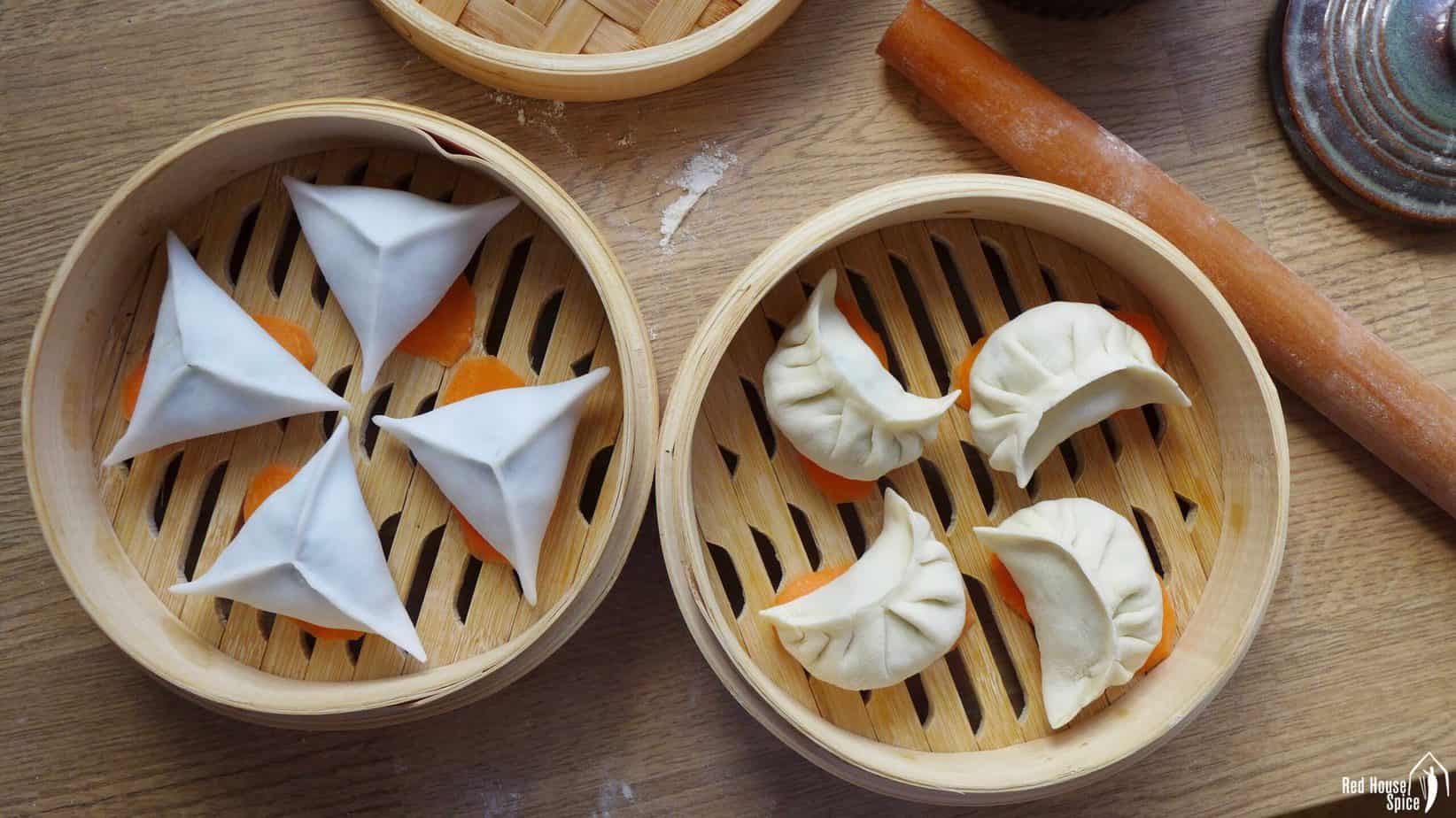
For shooting this recipe, I folded the regular dumplings into a classic crescent shape and the crystal ones into elegant triangles. The tutorial video in the recipe card below shows you how I pleated them step by step. I’ve also published a separate post on “Ten Ways to Fold Dumpling ” (also with a video). Check it out to find more inspirations.
Pleat the dumplings any way you like
Steamed dumplings require the least skills for pleating comparing to boiled or pan-fried ones. Please feel free to improvise, to shape your dumpling any way you like. Since the dumplings aren’t moved at all during the entire steaming process, small imperfections (e.g. not sealed properly, has a little leakage, etc.) won’t cause big problems.
Handle crystal wrappers with care
It’s fairly simple to fold with regular wrappers as they’re quite elastic and forgiving. But the crystal ones are much more delicate. They are not as stretchy thus tear more easily. So please try to handle them with care. I suggest you start with a little less filling than you would put in a regular dumpling. Increase the quantity once you’ve got the hang of it.
How to steam the dumplings
Here comes the simplest step of the entire process. Basically, what you need to do is to put the dumplings into a steamer basket then leaving them to steam until the moment when they are ready to be served. No hassle, right? Still, I’d like to offer a few tips to help you achieve a great result.
How to avoid sticking
No matter what type of steamer you use, you should always remember to place a lining between the dumplings and the steamer basket to avoid sticking (Nothing is worse than having all your dumplings stuck there). My favourite choice is slices of carrot. They work perfectly for the purpose. Also, they add a lovely colour to the dish, as well as some extra nutrition. Use chunky carrots and cut them diagonally to get bigger slices.
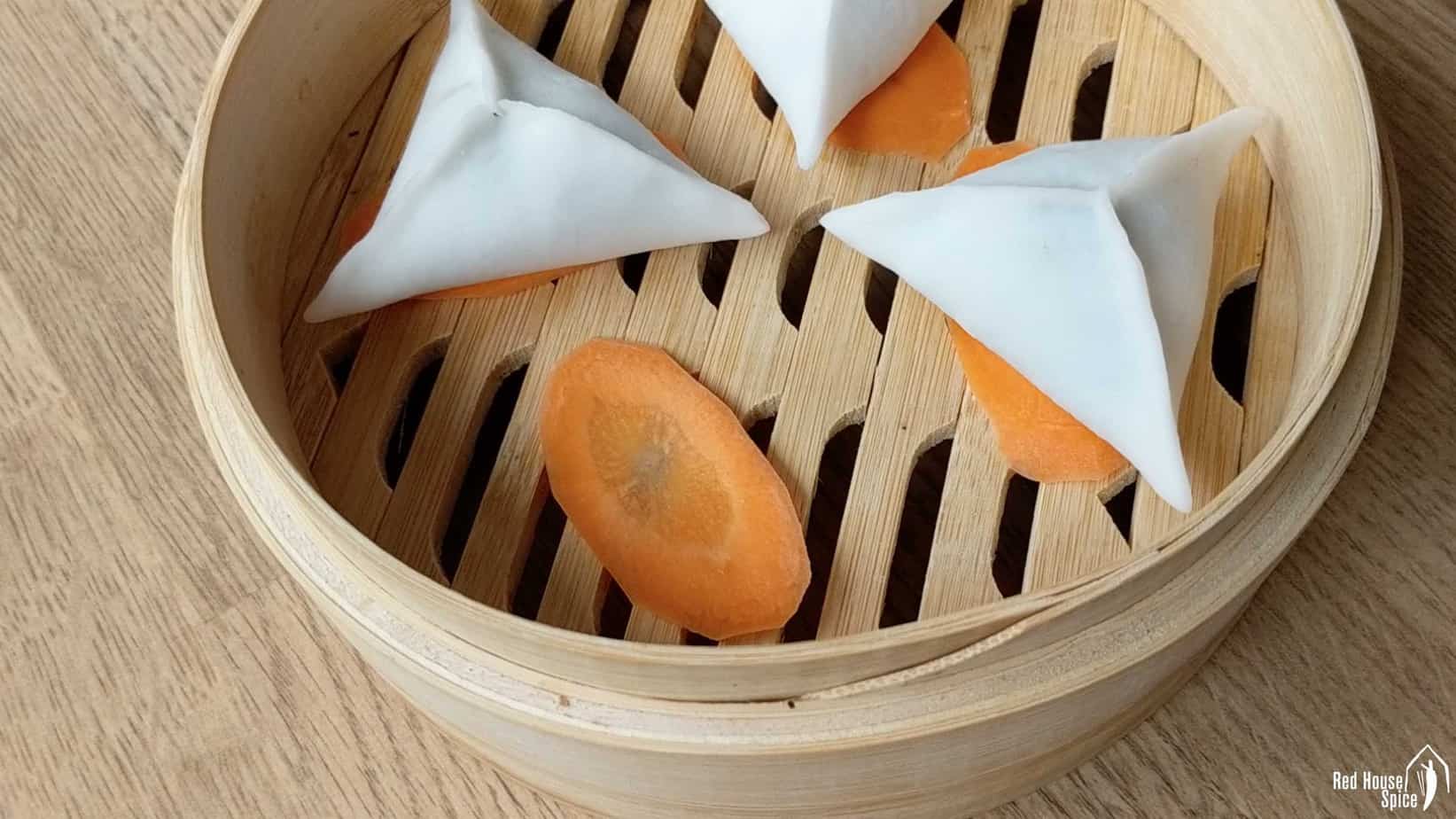
Alternatively, you may use leaves of a Napa cabbage, steamer parchment paper or regular parchment paper cut into a round shape with some holes. If you’re using a metal steamer, it also works to brush a thin layer of oil.
How long to steam
The next step: add water to the steamer pot. Bring it to a full boil then place in the steamer basket(s) filled with dumplings. Steam over medium heat for 10 minutes if you’re cooking regular dumplings or 6 minutes for crystal dumplings.
Isn’t it simple? So set a timer and relax. Please resist the urge to open the lid to peek during steaming. First of all, it’s unnecessary (your dumplings can’t run away, I promise). Secondly, the drop of pressure inside the steamer will necessitate a longer cooking time.
FAQ
A: Absolutely. Use a big wok/pot which comes with a lid. Pour in water then place a small bowl in the middle. Put dumplings onto a plate (ideally a very flat one) which is smaller than the wok/pot. Place it onto the bowl when the water starts to boil. Cover and steam the usual way.
A: Yes, you can. Stack them up and steam the usual way (Just like what you see in Chinese dim sum restaurants).
How to serve steamed dumplings
Let them sit for a minute
I’ve been making steamed dumplings (and steamed bao buns) for years, but I still find it very exciting every single time to open the lid and reveal these yummy beauties. It’s such a satisfying moment! But, don’t rush to pick them up straight away. Leave them in the basket for a minute or so as they tend to be a little sticky. This is particularly important when handling crystal dumplings. Otherwise, they might tear when sticking to chopsticks.
That said, do not let them cool too much either. It’s best to have steamed dumplings when warm. When completely cold, the wrapper will become harder and more rubbery.
Serve with a dipping sauce
Well-seasoned steamed dumplings taste great on their own. But it’s always nice to have a dipping sauce to add an extra zing. I have shared a post on “Six Dumpling Sauces” which is very popular with my readers. I’m sure you can find inspirations there. Alternatively, try a simple mix that I use regularly: black rice vinegar and homemade chili oil. It’s equally delicious and satisfying!
How to reheat, make-ahead & store
Two ways to reheat leftover dumplings
If you have any cooked dumplings leftover, put them in an airtight container and store in the fridge. Consume them within 2 days. There are two ways to reheat:
- Steam for 3-4 minutes.
- Pan fry over low heat with a little oil. Flip over several times to evenly heat.
Freeze uncooked dumplings
Uncooked dumplings freeze very well. If you wish to make a batch in advance, lay them in a single layer on a tray (lined with parchment paper) right after they’re assembled. Freeze until completely frozen. Then transfer to an airtight container/plastic bag. Store in the freezer for up to 2 months. Cook frozen dumplings without defrosting. Steam for 15 mins or so.
FAQ
A: Yes, they can be pan-fried or boiled. Please refer to my post “Cook Dumplings in Three Ways” for instructions. However, for the boiled version I personally prefer “cold water dough” to the two types of dough introduced in today’s recipe.
Other dumpling recipes
Here is a collection of dumpling dishes you might like:
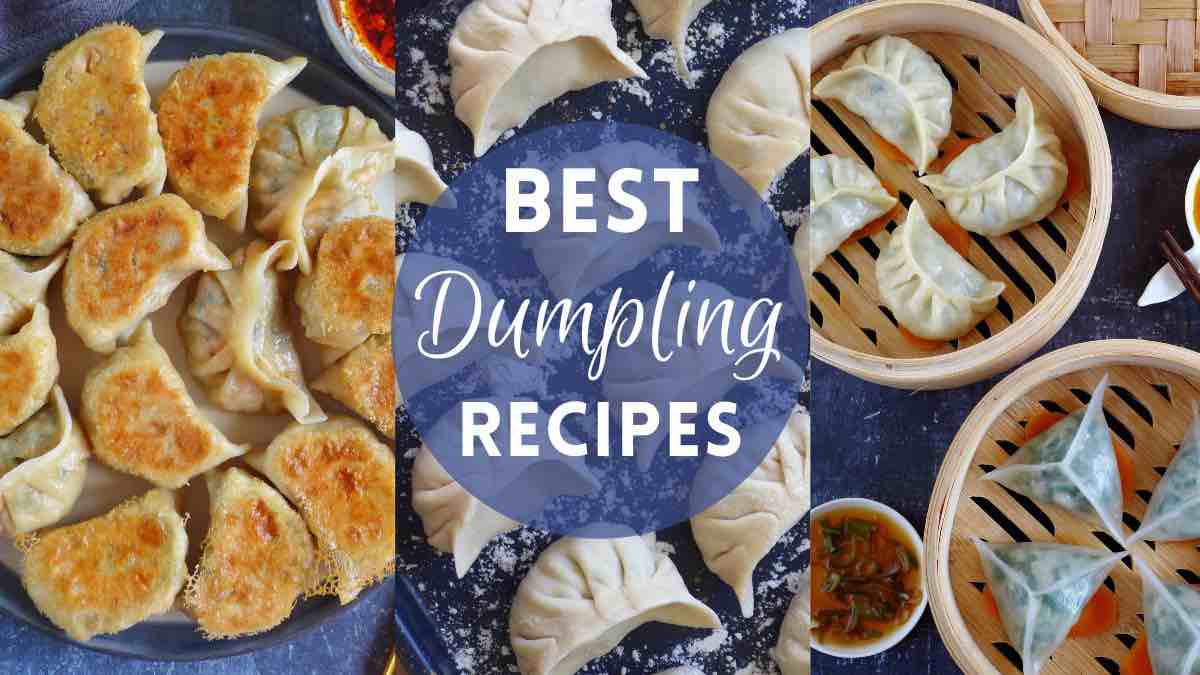
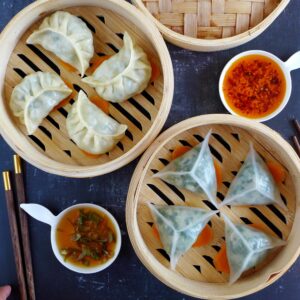
How to Make Steamed Dumplings, Two Ways (蒸饺)
Ingredients
For regular wrappers
- 230 g all-purpose flour - aka plain flour
- 100 g boiling water
- 30 g room temperature water - see note 1
For crystal wrappers
- 100 g wheat starch - (澄粉)
- 70 g tapioca starch/corn starch
- 170 g boiling water - see note 2
- 2 teaspoon cooking oil
For the filling (see note 3 for other filling options)
- 200 g minced pork
- ¼ teaspoon white pepper
- ¼ teaspoon salt
- ½ teaspoon sesame oil
- 2 tablespoon water - or stock
- 150 g Chinese chives - finely chopped
- 30 g canned water chestnuts - finely chopped
- 1 tablespoon papery dried shrimp - minced (optional, see note 4)
For steaming
- 24 slices carrot - see note 5 for other options
For serving (optional)
Instructions
Make the dough
- For regular wrappers: Pour boiling water into the flour while mixing with chopsticks. Then add room temperature water. Stir until no more liquid can be seen. Combine and knead with your hands until smooth. Cover the bowl then rest for 30 minutes.
- For crystal wrappers: Mix wheat starch and tapioca starch (or cornstarch) in a bowl. Pour boiling water over (It has to be just boiled). Stir with chopsticks immediately to distribute the water evenly. Then add oil. Combine and knead with your hands until very smooth. It can be used straight away. Remember to cover it well while preparing the filling.
Mix the filling
- Put minced pork into a mixing bowl. Add white pepper, salt, sesame oil & water. Stir to combine.
- Add Chinese chives, water chestnut & dried papery shrimp. Mix well then keep in the fridge until you’re ready to assemble the dumplings.
Roll the wrappers
- Divide the dough into two parts. Roll each part into a rope then cut into 12 equal sections (24 pieces in total).
- Use a rolling pin to flatten a piece into a thin disc, about 9-10cm in diameter (Please refer to the tutorial below). Dust with flour/starch if it sticks. Remember to cover the unused pieces to prevent them from drying out.
Assemble the dumplings
- Place a spoonful of filling on the wrapper. Fold and seal completely. The video below shows you how I fold them in half-moon shape and triangle shape.
- Check out my post and video on "Ten Ways to Fold Dumplings” if you wish to learn other techniques.
Steam the dumplings
- Scatter carrot slices in the steamer basket, then place dumplings on top (This is to avoid sticking. You may use parchment paper or coat the steamer with a thin layer of oil).
- Bring the water to a full boil, then place the basket in and cover with a lid.
- Steam over medium heat for 10 minutes for the regular dumplings, or 6 minutes for the crystal dumplings.
Serve the dumplings
- It’s best to enjoy steamed dumplings when warm.
- You can serve them on their own, with a simple mix of homemade chilli oil & black rice vinegar or with other delcious sauces found in my post "Six Dumpling Sauces".
Reheat leftovers
- Keep the leftover cooked dumplings in an airtight container in the fridge for up to 2 days. To reheat, you may either steam for 3-4 minutes or pan fry over low heat with a little oil until piping hot.
Make-ahead & freeze
- Right after the dumplings are assembled, lay them in a single layer on a tray. Freeze until completely frozen. Transfer to an airtight container/plastic bag. Store in the freezer for up to 2 months.
- Cook frozen dumplings: Do not defrost. Steam for 15 mins or so.
Video
NOTES
- Chicken & sweetcorn filling
- Beef & Chinese chive filling
- Dim sum style shrimp filling
- Pork & scallions filling
- Soup dumpling filling with aspic
- Shrimp, pork & mushroom filling
- Pork, carrot & onion filling
- Bok Choy, mushroom & vermicelli filling (vegetarian)
- Chinese chive, egg & vermicelli filing (vegetarian)
- Five-spice tofu & vegetable filling (vegan)
NUTRITION DISCLOSURE: Nutritional information on this website is provided as a courtesy to readers. It should be considered estimates. Please use your own brand nutritional values or your preferred nutrition calculator to double check against our estimates.



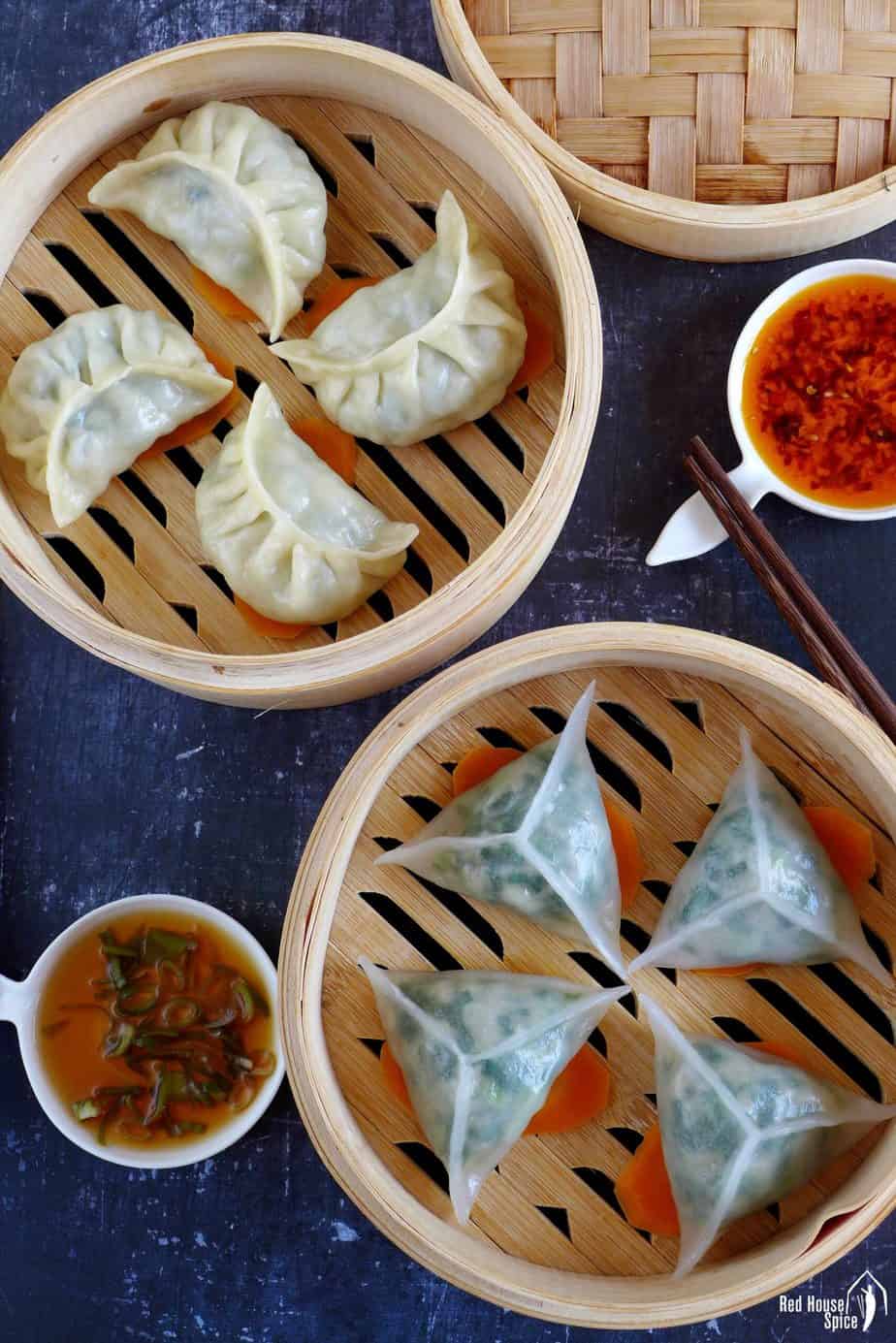
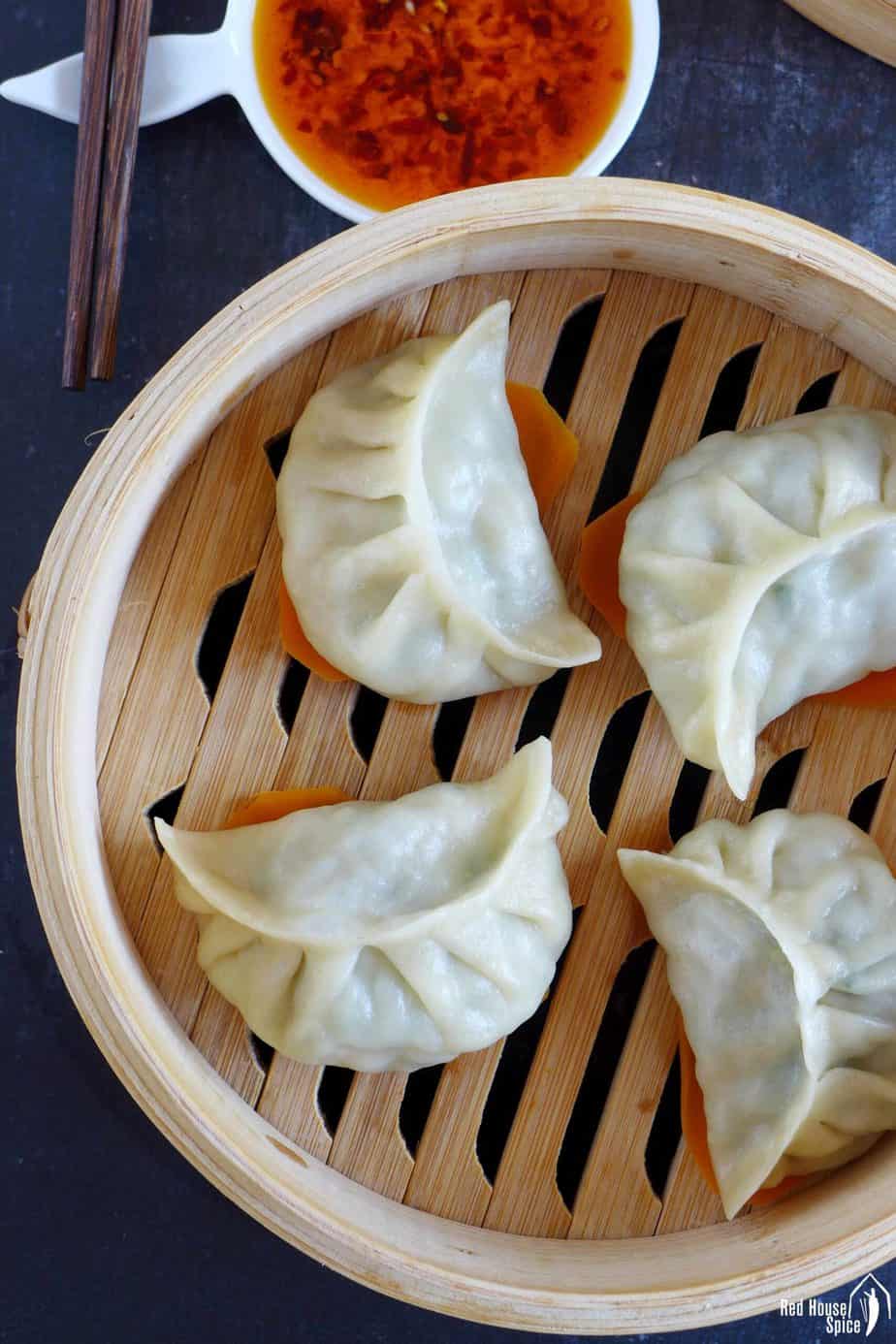
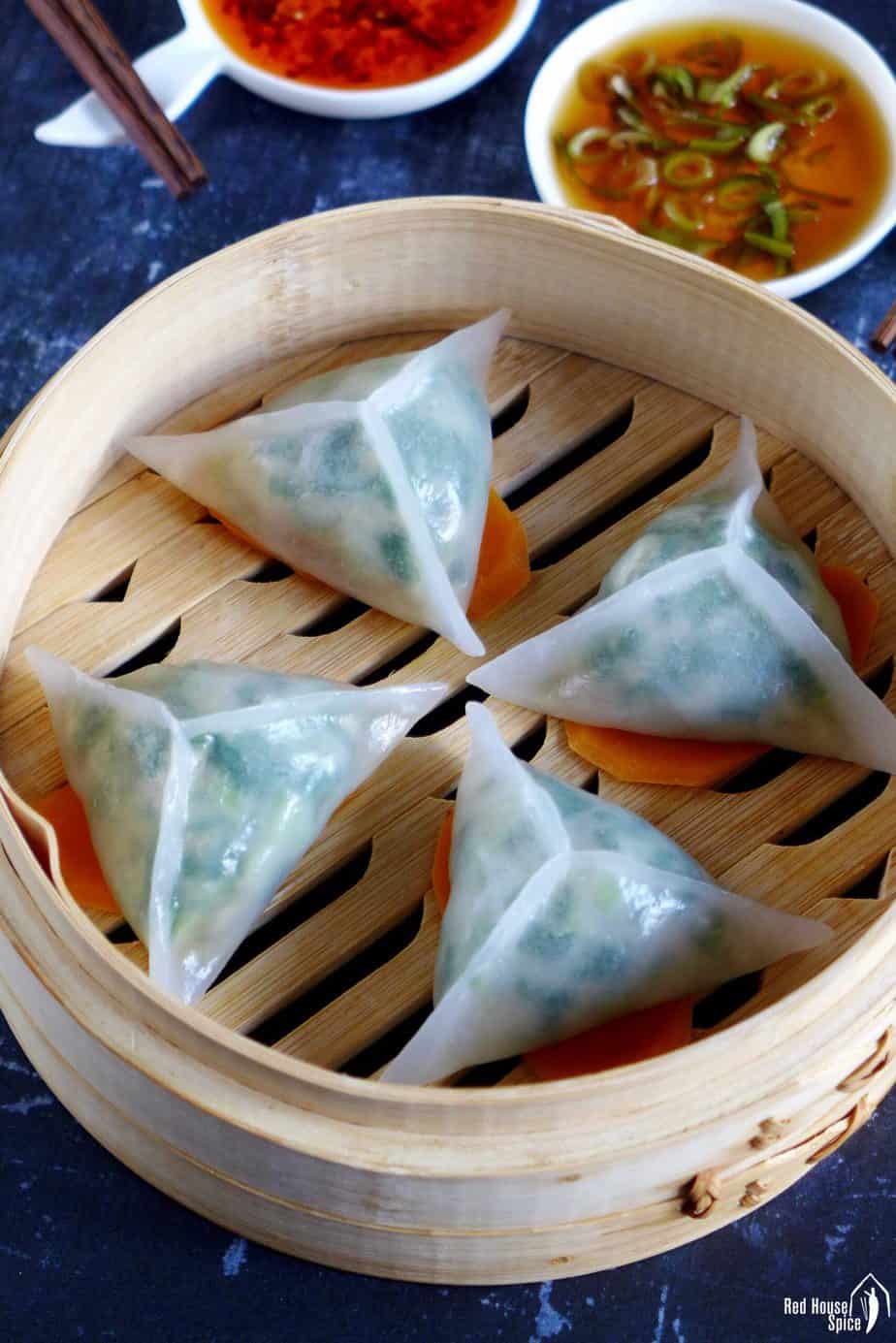
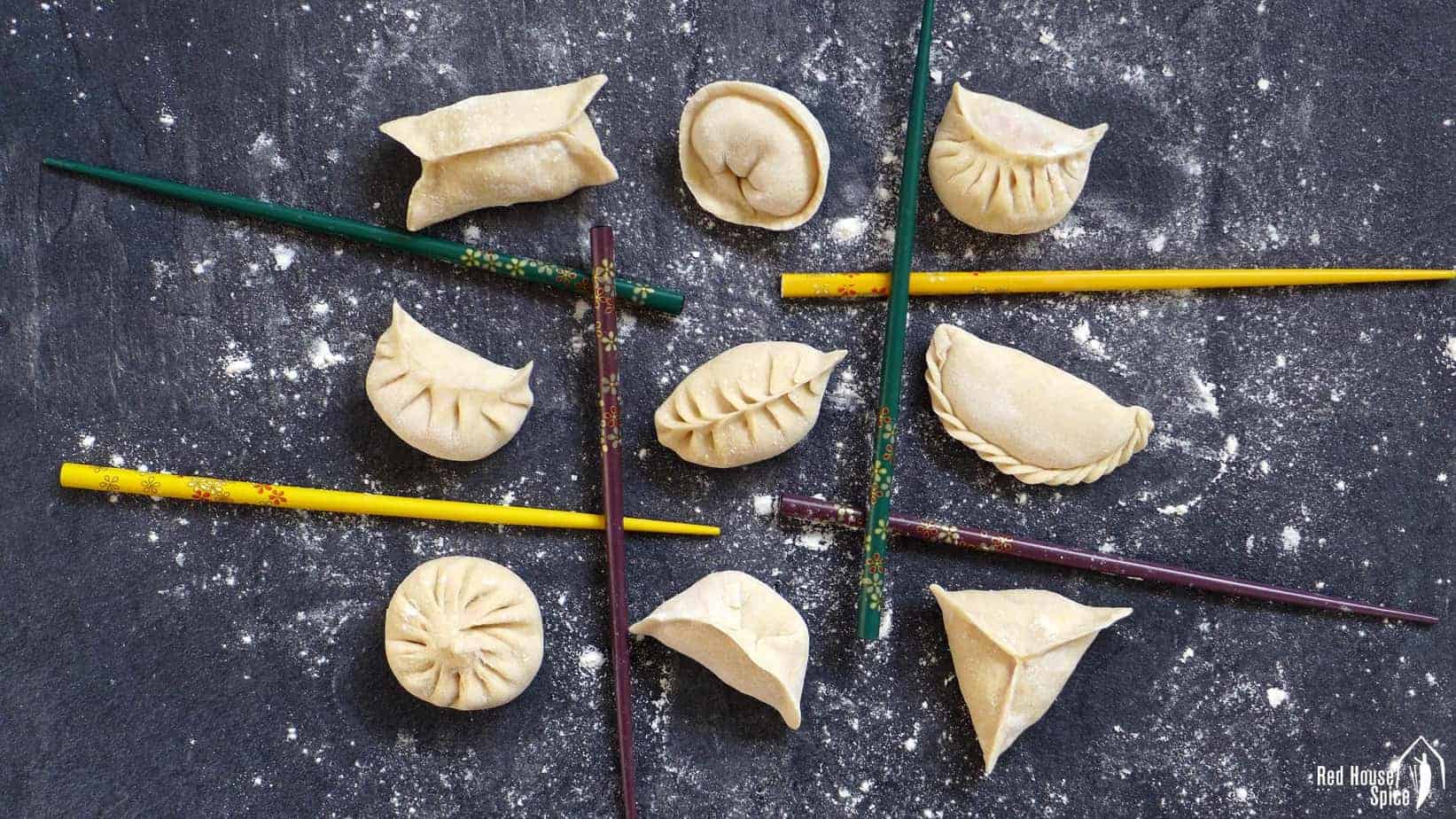
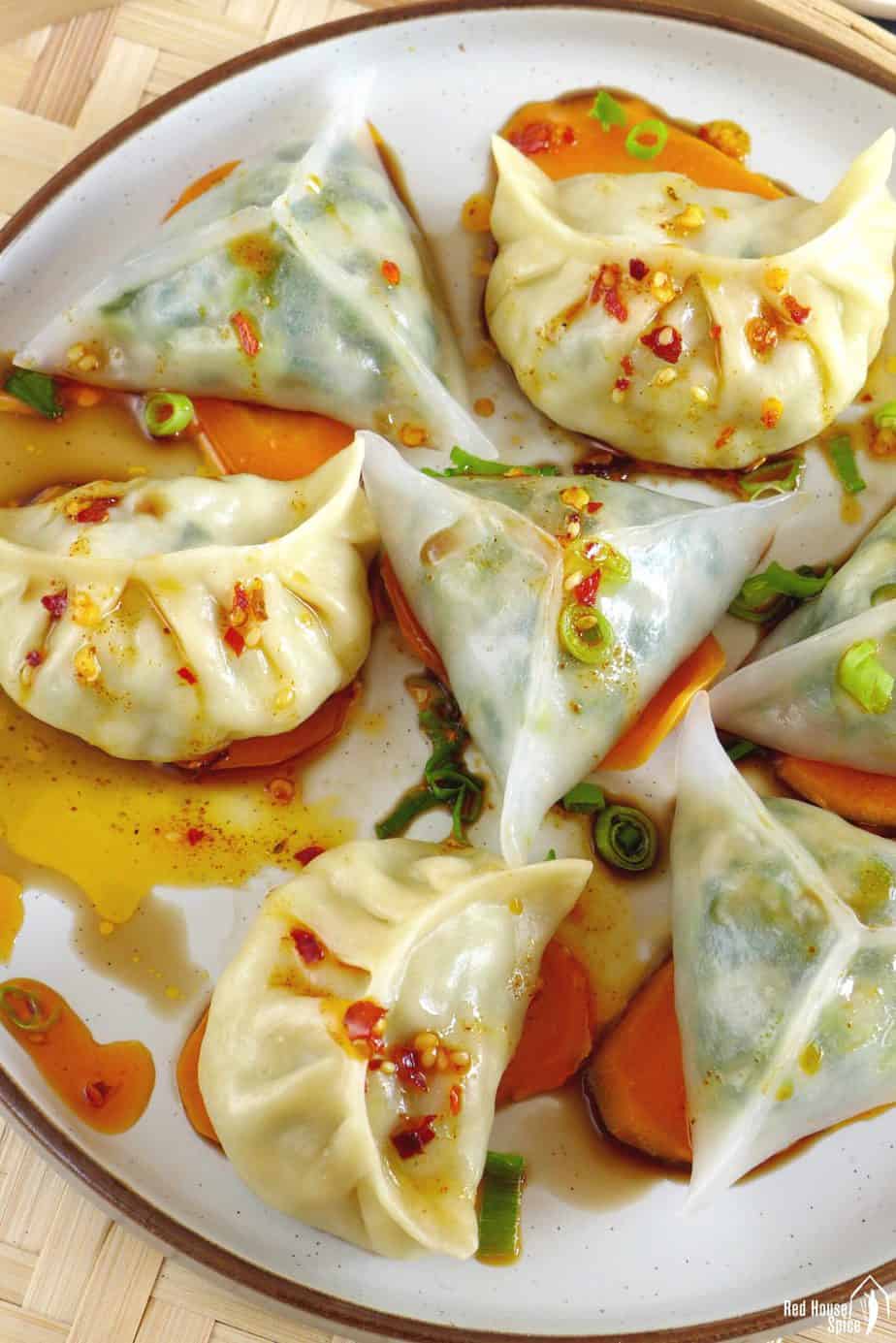
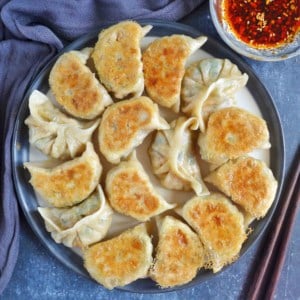
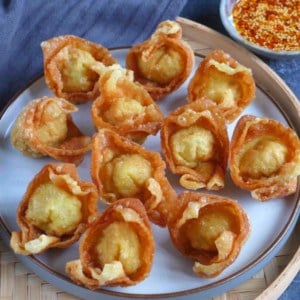
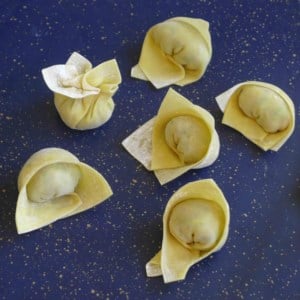
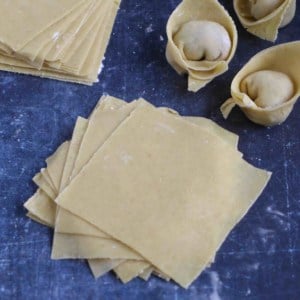
Love your recipes throughout your site. Regarding the crystal dough: I have made it several times and we enjoy it very much. I know that it does not need resting, but I am curious if it can sit for awhile if it is wrapped tightly? I am curious just because when we cook in my house we usually “go big”; making multiple dumpling recipes in tandem (2-5 different recipes is common). It’s two of us and we both have our jobs that we “specialize” in. My wife is the master folder and I the master roller. Either way, there are times when I would like to make the crystal dough and have it sit for thirty minutes to an hour (or even the day before) and I am curious if this would not be advised. We love Red House Spice! Keep up the good work.
Glad you and your wife enjoy my recipes! Yes, you can let the crystal dumpling dough sit provided you wrap it tightly. It’s ok to leave it on the counter for a few hours or in the fridge overnight. Bring it back to room temperature before rolling. Also, uncooked dumplings freeze well so you can make a big batch at once and enjoy them later. Happy steaming!
Thank you for the info. We know only to well about how well the dumplings freeze. We have at least 7 different varieties in our freezer currently. They are great for a quick meal or addition to a stir fry. Having some tonight for dinner actually!
So, I just made this recipe for dinner tonight. It was delicious. I absolutely loved the pork filling, and making the dough was very easy. Although I did not master the fancy pleats on the dumplings, the dough was very easy to work with and had no problem pinching them closed. This will definitely be in my menu rotation.
That’s wonderful to hear David. Have fun making more dumplings!
This looks great Wei.
I use a pastry scraper rather than a meat cleaver. Its flexible.
I have found your pleating of the xiao long bao (another post) wonderful
Thanks for the recipes and thoughtful detail to the backgrounds to your recipes
My pleasure to share David! Yes, pastry scraper could work too. I didn’t think of that.